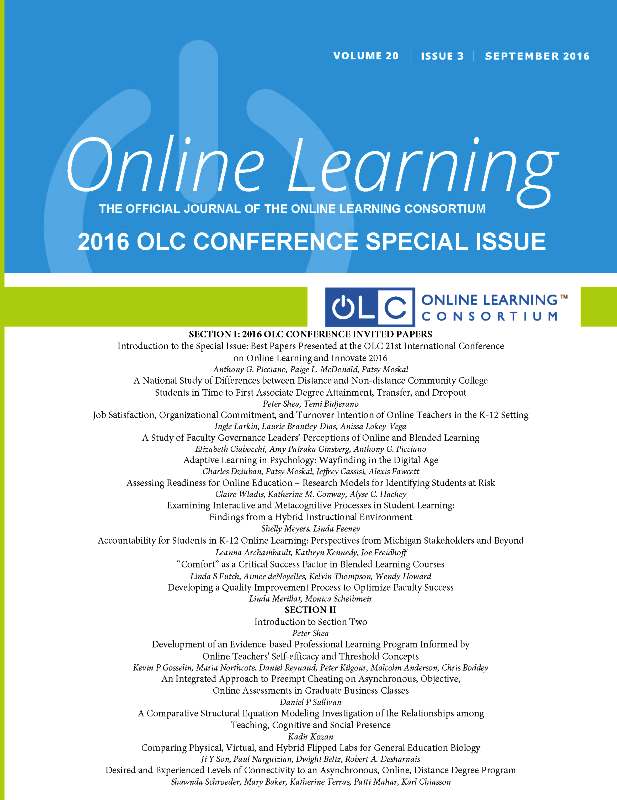A National Study of Differences between Distance and Non-distance Community College Students in Time to First Associate Degree Attainment, Transfer, and Dropout
DOI:
https://doi.org/10.24059/olj.v20i3.984Keywords:
Online learning, distance education, national study, community collegeAbstract
Abstract Previous research indicates that online learning at the community college level results in higher rates of withdrawal, failure, and dropout compared to classroom-based education (Xu & Smith Jaggars, 2011; Smith-Jaggars & Xu, 2010). The primary goal of the current study was to examine national data (US Dept. of Ed. Beginning Postsecondary Student Survey, 2004-09) on three outcomes for community college students with and without online education experiences. The outcomes were attainment of first associate degree, transfer, and dropout. In contrast to previous research, compared to exclusively classroom-based students, results suggest significantly more students who had engaged in online education had attained an associate degree at the end of the observation period. There were no significant differences in transfer or dropout. These results are interpreted with regard to their implications for policy and practice.References
Allen, E. & Seaman, J. (2004). Enter the mainstream: The quality and extent of online education in the United States 2003 and 2004. Babson Park, Mass.: Babson Survey Research Group and Quahog Research Group.
Allan, I.E. & Seaman, J. (2013). Changing course: Ten years of tracking online education in the United States. Babson Park, Mass.: Babson Survey Research Group and Quahog Research Group.
Brooks, D. (2012, May 4). The campus tsunami. The New York Times, A29. Retrieved from http://www.nytimes.com/2012/05/04/opinion/brooks-the-campus-tsunami.html
Jaggars, S.S. (2012). “Online learning in community colleges. In Handbook of Distance Education (3rd ed.), edited by Michael G. Moore, 594–608. New York: Routledge.
Jaggars, S.S., Edgecombe, N., & Stacey, G.W. (2013). What we know about online course outcomes. Community College Research Center, Teachers College, Columbia University, April 2013, 1-8.
Jaggars, S.S., & Xu, D. (2013). Predicting online student outcomes from a measure of course quality (Working Paper 57). New York, NY: Community College Research Center, Teachers College, Columbia University.
Johnson, H. & Cuellar Mejilla, M. (2014). Online Learning and Student Outcomes in Community Colleges Public Policy Institute of California.
Muthén, B., & Masyn, K. (2004). Discrete-time survival mixture analysis. Journal of Educational and Behavioral Statistics, 30(1), 27-58.
National Center for Education Statistics (2010). Persistence and Attainment of 2003–04 Beginning Postsecondary Students: After 6 Years: First Look (NCES 2011-151). U.S. Department of Education.
National Center for Education Statistics (2011). Projections of Education Statistics to 2020. U.S. Department of Education.
Organization for Economic Cooperation and Development (2013). Education at a Glance 2013: OECD Indicators. US Country Notes. Downloaded from: http://www.oecd.org/edu/United%20States%20_EAG2013%20Country%20Note.pdf
Pappano, L. (2012, November 2). The year of the MOOC. The New York Times, ED26. Retrieved from http://www.nytimes.com/2012/11/04/education/edlife/massive-open-online-courses-are-multiplying-at-a-rapid-pace.html
Parsad, B., and Lewis, L. (2008). Distance education at degree-granting postsecondary institutions: 2006–07 (NCES 2009–044). National Center for Education Statistics, Institute of Education Sciences, U.S. Department of Education. Washington, DC.
Radford, A. (2011). Learning at a distance undergraduate enrollment in distance education Courses and Degree Programs (NCES 2012-154). National Center for Education Statistics, Institute of Education Sciences, U.S. Department of Education. Washington, DC.
Russell, A. (2010). A guide to major U.S. college completion initiatives. American Association of State Universities and Colleges.
Scott, M. A., & Kennedy, B. B. (2005). Pitfalls in pathways: Some perspectives on competing risks event history analysis in education research. Journal of Educational and Behavioral Statistics,30, 413- 442. DOI: 10.3102/10769986030004413
Shea P. & Bidjerano, T. (2014). Does online learning impede degree completion? A national study of community college students. Computers and Education, 75 (2), 103-111.
Singer, J. D., & Willett, J. B. (2003). Applied longitudinal data analysis: Modeling change and event occurrence. New York: Oxford University Press.
Sparks, S. (2011, September 13). U.S. postsecondary edge shrinking among G-20 countries. Education Week.
Vaughan, G. B. (2006). The community college story. Washington, DC: Community College
Press.
Xu, D., & Jaggars, S. S. (2013). Adaptability to online learning: Differences across types of students and academic subject areas. (CCRC Working Paper No. 54). Community College Research Center. Teachers College, Columbia University.
Downloads
Published
Issue
Section
License
As a condition of publication, the author agrees to apply the Creative Commons – Attribution International 4.0 (CC-BY) License to OLJ articles. See: https://creativecommons.org/licenses/by/4.0/.
This licence allows anyone to reproduce OLJ articles at no cost and without further permission as long as they attribute the author and the journal. This permission includes printing, sharing and other forms of distribution.
Author(s) hold copyright in their work, and retain publishing rights without restrictions






